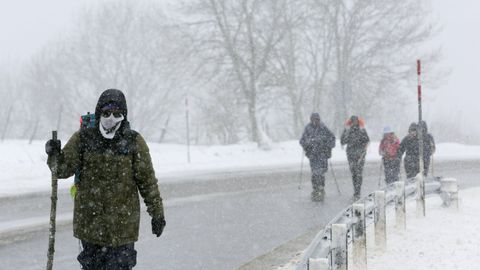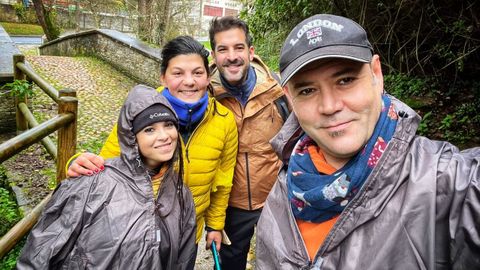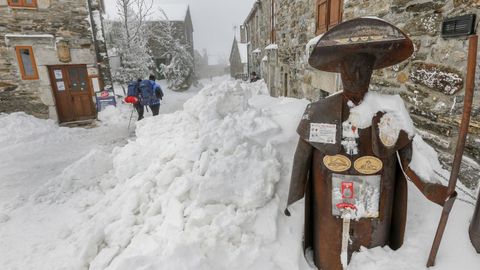
Experienced pilgrims offer their advice on what clothing and backpack to take and how to organise the various stages.
10 feb 2022 . Actualizado a las 18:33 h.See the snow-covered pallozas (traditional Celtic dwellings) in and around O Cebreiro, take in the majestic rivers snaking across the countryside, cross wintry forests where all you can hear is silence... These are just some of the wonderful experiences awaiting you on the Winter Camino de Santiago. Putting on your boots and setting out on foot in the coldest months of the year can certainly be a challenge, but there are pilgrims who choose this time of year to see the pilgrimage routes in a different light. So what advice do they offer?
“It all depends on the route you choose,” says Cristina García, who has done the pilgrimage in all four seasons. “If you choose the Camino Francés (French Way), the Camino Primitivo (Original Way), the Camino de Invierno (Winter Way) or the Via de la Plata (Silver Way), which are all inland routes, you will notice a bigger difference in temperature. If instead you choose the Camino de Costa (Coastal Way), such as the Camino Inglés (English Way), or the Camino Portugués (Portuguese Way), or even the Camino Finisterre (Finisterre Way), the temperatures are typically milder,” she explains.

What route to choose
Ramiro Oliveira has experienced all the routes except the maritime one, and recommends the coastal ways. “You can find rain on any of the routes and in any season, but the Portuguese Way has more in the way of amenities, milder temperatures and it tends to rain less in the south of Pontevedra than as we get closer to Santiago,” he explains. And he knows what he’s talking about. He has worked at several lodgings in and around Santiago de Compostela, so he has been in close contact with pilgrims all his life. This led him to create a website about the Jacobean routes, where he offers valuable tips and advice.
“The Winter Way, which steers clear of the snow around O Cebreiro coming from the northern part of the province of Ourense, is another great choice for this time of year. Depending on the month you choose, there are fewer amenities, but if you plan well there is plenty of accommodation to be found,” he adds.
How to organise the stages
Proper organisation is an absolute must for doing the Camino de Santiago at any time of year, but in winter this step becomes even more important.
“From the Pilar long weekend onwards many lodgings close their doors, so I would definitely recommend booking in advance to avoid nasty surprises. It’s not a good time of the year for those looking to wing it,” says Ramiro.

Another problem with doing the pilgrimage during the winter months is the hours of daylight you have. “You don’t have to rush or get up at five in the morning to find lodging later in the day. The problem is not getting to the end of the stage, but what you do afterwards. If you then want to do some sightseeing, it’s going to be night-time for sure,” explains the native from Santiago de Compostela.
Cristina has a solution to the problem: “I start walking very early in the morning to reach the end of the stage with some daylight hours left. If necessary, I might even shorten the stages. Instead of doing 28 kilometres in one day, I would split it into two stages.” Most routes have accommodation at various points along each stage, so finding a bed is not a problem. “I don’t walk at night because I want to see the Camino and the places I pass through. I would rather do fewer miles in more days than more miles in fewer days,” she adds. And if the sun does go down while you’re still walking, it’s important to have a miner’s style head lamp in your pack, she explains.
What to put in your backpack
The equipment you need to go on a Jacobean adventure in winter is another essential part of the planning process. “Everyone has their own way of doing the Route. I’m one of those who brings just a couple of changes of clothes. I pack light because I know that a heavy backpack and the resulting back pain can be a real problem and can take all the enjoyment out of the experience. Don’t be one of those “just in case” types. You can always find somewhere to buy anything you may need along the way,” Ramiro explains.

Ideally the backpack should not weigh more than 10% of your body weight. On this point, Cristina has some useful advice on how to avoid carrying too much around with you: “Most lodges have laundry and drying facilities. What I would do is plan where I’m going to stay and check that those services are available because you will end up saving a lot of weight in your backpack.”
What to wear
But what should I be wearing? “It depends very much on the individual. I like to wear shorts from first thing in the morning and a windbreaker with a zipped fleece lining so I can adjust it depending on how cold I am. It’s also a good idea to wear a pair of detachable trousers so you can switch from long trousers to shorts when things warm up,” says Ramiro.
The best option, according to both experienced pilgrims, is to wear breathable outdoor apparel and if you wear a coat then make it a light one. A small umbrella can be added to your mackintosh, which you’re “going to need at any time of the year.” Both of them also recommend taking a neck warmer. “I would take gloves and a hat if I was doing an inland route,” Cristina explains. As for the need to wear sunscreen, she thinks it’s probably a good idea, but it’s even more important to bring lip balm to protect your lips from the cold.

Footwear should be waterproof and properly worn in beforehand to avoid hurting your feet. While in summer it may be advisable to wear more breathable trekking shoes or sandals, in winter your best bet would be to wear proper hiking boots. “Before you start walking, it’s always a good idea to smear your feet with petroleum jelly and then put your socks on. Make sure they are always dry and bring several pairs along with you so you can change them throughout the stage,” recommends Cristina.
A different experience
But our greatest recommendation is undoubtedly to do the pilgrimage in winter as well. “It’s a wonderful time of year to do the pilgrimage. There are hardly any people around, you will see a different kind of landscape and you can also enjoy some typical wintry cuisine. A good broth of turnips or turnip greens, for example. As we are entering the carnival season, you are sure to find pancakes, ear-shaped fried dough and other delicious pastries in many places,” remarks Cristina. “The route is always the same, but depending on the season you are sure to experience a different Way,” she adds.
The changing landscape is one of the main reasons why both experts recommend doing a pilgrimage in all seasons of the year. But if they had to pick just one advantage of doing it in the winter, it would be that there are fewer people around. “You can do a more spiritual Camino, or one of personal discovery,” explains Ramiro, who believes that “there is a Camino for everyone, at any time of year.”